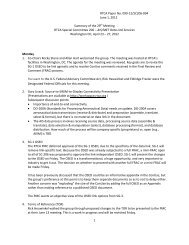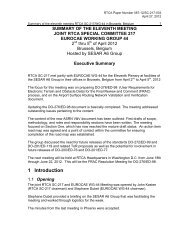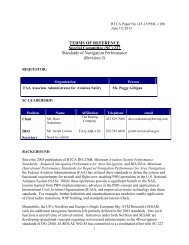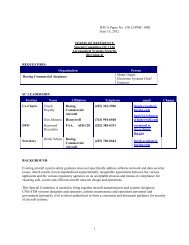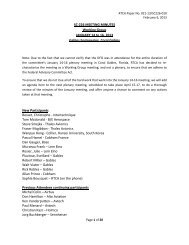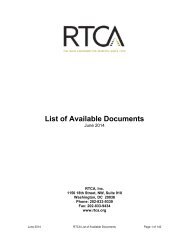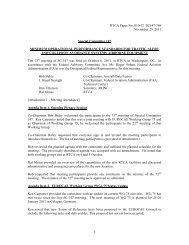Summary of the First Meeting Special Committee 227 ... - RTCA
Summary of the First Meeting Special Committee 227 ... - RTCA
Summary of the First Meeting Special Committee 227 ... - RTCA
You also want an ePaper? Increase the reach of your titles
YUMPU automatically turns print PDFs into web optimized ePapers that Google loves.
During <strong>the</strong> course <strong>of</strong> <strong>the</strong> meeting discussions, a number <strong>of</strong> issues related to aeronautical information and<br />
databases were raised e.g. changes in RF, FRT, displays, etc. Dave pointed out that in <strong>the</strong> committee<br />
planning he had raised such issues and documents DO-200A and DO-201A. However, it was felt that <strong>the</strong><br />
scope was too large for <strong>the</strong> committee schedule. With <strong>the</strong> committee discussions, it was apparent that all<br />
<strong>the</strong> pieces for addressing lessons learned and new additions need to be worked in order to achieve success<br />
in implementation. It was pointed out that <strong>RTCA</strong> was considering expanding <strong>the</strong> scope <strong>of</strong> SC-217,<br />
Terrain and Airport Databases to add navigation. A number <strong>of</strong> <strong>the</strong> committee including <strong>the</strong> chair<br />
expressed concern that splitting <strong>of</strong>f <strong>the</strong> effort might make sense from a functional standpoint but by being<br />
tackled by a group with a totally different perspective and goals, could also lead to divergent solutions<br />
and increased complexity for SC-<strong>227</strong> standards. Dave pointed out that this adds <strong>the</strong> need for close<br />
coordination with this committee as well as SC-214 and SC-186 in moving forward. Dave will make<br />
<strong>the</strong>se points known to <strong>RTCA</strong>.<br />
Schedule Discussion regarding MOPS Update<br />
Do we need <strong>the</strong> MOPS done at <strong>the</strong> same time as <strong>the</strong> MASPS<br />
It may be a long process after <strong>the</strong> completion <strong>of</strong> <strong>the</strong> MOPS for it to go into <strong>the</strong> TSO, so it should be okay<br />
if <strong>the</strong> MOPS are delayed until after <strong>the</strong> MASPS are complete. We can start MOPS activity before <strong>the</strong><br />
MASPS are complete, but we may not be able to focus <strong>the</strong> full group attention on <strong>the</strong> MOPS until <strong>the</strong><br />
MASPS are complete.<br />
JohnH: we can start fixing <strong>the</strong> text <strong>of</strong> <strong>the</strong> MOPS right away. We need <strong>the</strong> fixes made, and this can be<br />
done before <strong>the</strong> MASPS are done. The new stuff will need to wait, but not <strong>the</strong> fixes.<br />
Walk Through <strong>of</strong> DO-283A MOPS<br />
Dave pointed out that he was leading this discussion only because a lead had not been found by <strong>the</strong> time<br />
<strong>of</strong> <strong>the</strong> meeting. He stated that as an aircraft and systems person, it would be more appropriate to have an<br />
equipment manufacturer with experience in MOPS, TSO’s and related regulatory approvals in front <strong>of</strong><br />
this effort. Until <strong>the</strong>n, and for this session only Dave quickly skimmed over <strong>the</strong> content <strong>of</strong> <strong>the</strong> MOPS and<br />
discussed how it adds specificity to <strong>the</strong> MASPS and leaves out background rationale information that is<br />
not needed to describe <strong>the</strong> requirements.<br />
Dave mentioned a number <strong>of</strong> areas that may require changes including:<br />
RNP Scalability: <strong>the</strong> current MOPS provides specific criteria for set RNP values but also provides<br />
guidance with regard to <strong>the</strong> applicability to o<strong>the</strong>r RNP values and especially for <strong>the</strong> lateral<br />
deviations. However, more may be required with regard to factors such as acceptability <strong>of</strong><br />
current discrete alerting levels or what mitigations will work<br />
VOR/DME is included as with <strong>the</strong> MASPS. However <strong>the</strong> MASPS goes, so will <strong>the</strong> MOPS.<br />
Currently <strong>the</strong> MOPS is only 2D. What becomes <strong>the</strong> minimum set <strong>of</strong> requirements e.g. VNAV<br />
and TOAC needs to be discussed and determined.<br />
The test sections may need updating for DO-160, as well as additional test scenarios for functions<br />
and performance for sequential RF turns, datacom, data outputs , etc.<br />
Hardware/S<strong>of</strong>tware compliance<br />
Relevant electronic display features/performance for <strong>the</strong> installed system<br />
All MASPS changes that correspond to a MOPS requirement.<br />
Dave also mentioned that more may be appropriate but will require <strong>the</strong> knowledge and perspective <strong>of</strong><br />
those who actually need and use <strong>the</strong> MOPS as a basis for equipment development and approvals.<br />
Regarding holding – we may need to address lessons learned regarding disconnects between expectations<br />
and content.<br />
20




